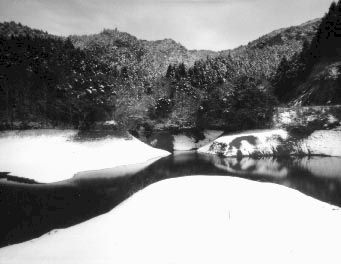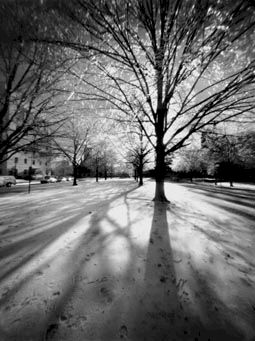Pinhole Cliche
This morning I went out to photograph the snow. If we are lucky we get one or two snows a year where I live. What little accumulation we have usually melts by 10 am. Most landscape photographers want a few snow pictures in their files so I dutifully got up early and went out in search of "snow images." Pinhole camera of choice was the adjustable Finney 4x5 inch (for ease of use in the cold) with black and white film.
The melt factor meant I had to work fast. Looking around I saw many possible images. I had photographed these snow covered rice paddies many times before with a regular camera. And soon I found myself photographing the same thing again with the pinhole.
"Gotta get the snow pictures" ran through the mind. I market a lot of my country and nature scenes to magazines and books and if I am going to market my pinhole art work to the editorial market, I needed to get some more "snow" in my stock files. So there I was like any normal photographer planning the shot, thinking of composition, looking at the patterns of the snow, and thinking "cliche".
It was freezing cold (which I hate) and I wondered if I was really inspired or just going through the motions, as if it were an assignment and I had to get the images. It would likely be the only chance for snow pictures this year, so there was little room for error.
Later, back inside the house in front of the warm heater I started thinking about the way I worked this morning. Did I get anything "original"? Did I get an image that brings out the special qualities of pinhole photography as no other camera can? Or did I get a cliche image that happened to be made with a pinhole camera? Did I get a "good" image regardless of the camera I used? Or did I get a cliche pinhole image?
In Japanese there are two words describing ones intentions: "giri" and "ninjo". Giri means doing something out of duty. Ninjo means doing something from the heart because one really wants to do it. Could the cliche photo be the result of giri and the artistic "masterpiece" the result of ninjo?
Recently a magazine editor looked at my online portfolio. She hasn't seen my original prints yet and knows nothing about pinhole. Later over the phone she asked innocently, if these kinds of images could only be made with a pinhole camera. It is not the first time I have been asked this question. And I find it hard to answer.
I used to think the answer was yes. Then I saw West Coast photographer Patrick Jablonski's photos in a gallery in California. I thought for sure they were pinhole photos. The sea was white and soft, the clouds dreamily streaked across the sky. But I noticed the rocks were really sharp, large format lens style sharp. Then someone told my simple self how it could be done. Select the lens' smallest aperture and put a dark neutral density filter over it to slow down the shutter speed even more. Voila, one creates a pinhole-like image using a regular camera. I admit I use a similar technique when "forced" to use a standard camera. Simply use a tripod (a discipline I have mastered from using pinhole cameras), and use the slowest shutter speed I can get.
I sometimes stress the fact that I use a pinhole a camera as a "sales" or "publicity" point. The world of photography is a competitive place and one needs all the help one can get. But in truth I prefer not to mention it unless asked. I want the images to stand on their own, regardless of how I made them. I use pinhole cameras because they are the best tools to help express my vision.
People are often surprised my photos are made with these simple cameras. I take this as a compliment. Other times it is obvious. I consider myself as coming from the traditional world of photography. Though I use a simple pinhole camera to record the image, once in the darkroom I employ standard "state of the art" know how. Yet I do strive to keep the feeling of pinhole through my choice of printing paper, the tone of the print, and critical editing.
So what is a cliche pinhole image and am I "guilty" of making them? With pinhole, there is often blurred movement, black around the edges, distortion, real yet somehow soft, a view of another dimension. Multiple pinholes and overlapping images, worms eye view, and curved film planes. Then there is the advantageous use of infinite depth of field, or the trick of having a background that moves, thus throwing it out of focus. Some artists, (Eric Renner comes to mind) use the pinhole camera as a tool for creating conceptual art. Are these "devices" that create cliche pinhole photographs or are they creating "classic pinhole imagery", as a pinhole photographer friend suggested?

A good cliche image should still be a good image. Maybe even a great rendering of a cliche is possible. As photographer, teacher, and sometimes critic Larry Bullis said to me, "things become cliche because there is truth in them."
It is very difficult to create something that is really new. Tradition says, "there are no new truths," but concerned photographers and artists try anyway. Perhaps it is giri, and part of our duty. But if the photograph (or other artwork) also comes from the heart as ninjo, I believe it will succeed as "art".
